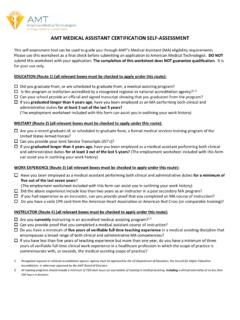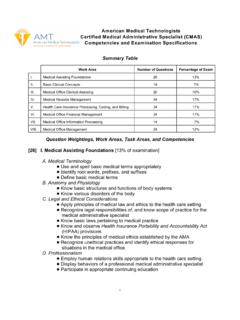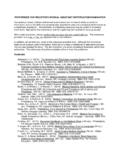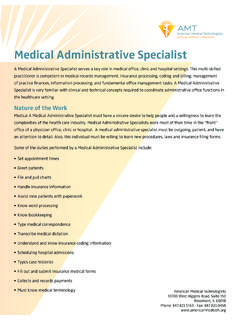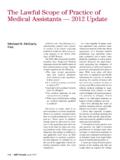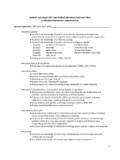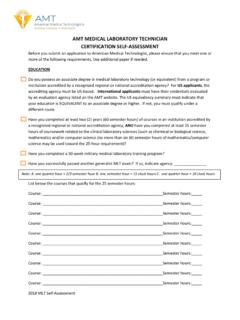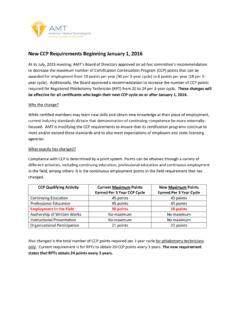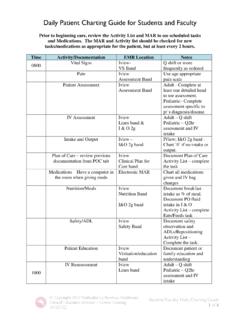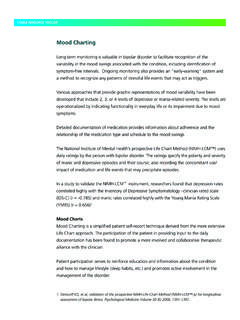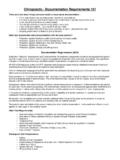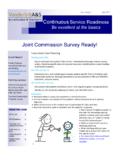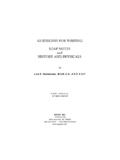Transcription of REGISTERED MEDICAL ASSISTANT CERTIFICATION …
1 REGISTERED MEDICAL ASSISTANT CERTIFICATION EXAMINATION. COMPETENCIES AND CONSTRUCTION PARAMETERS. [Work Area]. Number [Category]. of [Sub-category]. Items [Competency]. _____ _____. 86 I. GENERAL MEDICAL ASSISTING KNOWLEDGE. A. Anatomy and Physiology 1. Body systems Identify the structure and function of the following systems: a. skeletal g. nervous b. muscular h. respiratory c. endocrine I. cardiovascular/circulatory d. urinary j. integumentary e. reproductive k. special senses f. gastrointestinal 2. Disorders and diseases Identify and define various: a. disease processes b. conditions or states of health c.
2 Health-related syndromes 3. Wellness a. Identify nutritional factors that are required for, or influence wellness b. Identify factors associated with exercise that are required for, or influence wellness c. Identify factors associated with lifestyle choices that are required for, or influence wellness B. MEDICAL Terminology 1. Word parts a. Identify word parts: root, prefixes, and suffixes 2. Definitions a. Define MEDICAL terms 1. 3. Common abbreviations and symbols a. Identify and understand utilization of MEDICAL abbreviations and symbols 4. Spelling a. Spell MEDICAL terms accurately C. MEDICAL Law 1. MEDICAL law Identify and understand the application of: a.
3 Types of consent used in MEDICAL practice b. disclosure laws and regulations (including HIPAA Security and Privacy Acts, state and Federal laws). c. laws, regulations, and acts pertaining to the practice of medicine d. scope of practice acts regarding MEDICAL assisting e. Patient Bill of Rights legislation 2. Licensure, CERTIFICATION , and registration a. Identify credentialing requirements of MEDICAL professionals b. Understand the application of the Clinical Laboratory Improvement Amendments of 1988. (CLIA 88). 3. Terminology a. Define terminology associated with MEDICAL law D. MEDICAL Ethics 1. Principles of MEDICAL ethics and ethical conduct a.
4 Identify and employ proper ethics in practice as a MEDICAL ASSISTANT b. Identify the principles of ethics established by the American MEDICAL Association c. Identify and understand the application of the AMA Patient Bill of Rights d. Recognize unethical practices and identify the proper response e. Recognize the importance of professional development through continuing education E. Human Relations 1. Patient relations a. Identify age-group specific responses and support b. Identify and employ professional conduct in all aspects of patient care c. Understand and properly apply communication methods d. Identify and respect cultural and ethnic differences e.
5 Respect and care for patients without regard for age, gender, sexual orientation, or socioeconomic level 2. 2. Interpersonal relations a. Employ appropriate interpersonal skills with: 1. employer/administration 2. co-workers 3. vendors 4. business associates b. Observe and respect cultural diversity in the workplace F. Patient Education 1. Patient instruction Identify and apply proper written and verbal communication to instruct patients in: a. health and wellness b. nutrition c. hygiene d. treatment and medications e. pre- and post-operative care f. body mechanics g. personal and physical safety 2. Patient resource materials a.
6 Develop, assemble, and maintain appropriate patient brochures and informational materials 3. Documentation a. Understand and utilize proper documentation of patient encounters and instruction 51 II. ADMINISTRATIVE MEDICAL ASSISTING. A. Insurance 1. Terminology a. Identify and define terminology associated with various insurance types in the MEDICAL office 2. Plans a. Identify and understand the application of government, MEDICAL , disability, and accident insurance plans b. Identify and appropriately apply plan policies and regulations for programs including: 1. HMO, PPO, EPO, indemnity, open, etc. 2. short-term and long-term disability 3.
7 Family MEDICAL Leave Act (FMLA). 4. Workers' Compensation a. Complete first reports b. Complete follow-up reports 3. 5. Medicare (including Advance Beneficiary Notice (ABN)). 6. Medicaid 7. CHAMPUS / Tricare and CHAMPVA. 3. Claims a. Complete and file insurance claims 1. File claims for paper and Electronic Data Interchange 2. Understand and adhere to HIPAA Security and Uniformity Regulations b. Evaluate claims response 1. Understand and evaluate explanation of benefits 2. Evaluate claims rejection and utilize proper follow-up procedures c. Coding a. Identify HIPAA-mandated coding systems and references 1.
8 ICD-10-CM. 2. CPT. 3. HCPCS. b. Properly apply diagnosis and procedure codes to insurance claims 4. Insurance finance applications a. Identify and comply with contractual requirements of insurance plans b. Process insurance payments and contractual write-off amounts c. Track unpaid claims d. Generate aging reports 5. Financial Bookkeeping 1. Terminology a. Understand terminology associated with MEDICAL financial bookkeeping 2. Patient billing a. Maintain and explain physician's fee schedules b. Collect and post payments c. Manage patient ledgers and accounts d. Understand and prepare Truth in Lending Statements e.
9 Prepare and mail itemized statements f. Understand and employ available billing methods g. Understand and employ billing cycles 3. Collections a. Prepare aging reports and identify delinquent accounts b. Perform skip tracing c. Understand application of the Fair Debt Collection Practices Act d. Identify and understand bankruptcy and small claims procedures e. Understand and perform appropriate collection procedures 4. 4. Fundamental MEDICAL office accounting procedures a. Employ appropriate accounting procedures 1. Pegboard / double entry 2. Computerized b. Perform daily balancing procedures c. Prepare monthly trial balance d.
10 Apply accounts receivable and payable principles 5. Banking procedures a. Understand and manage petty cash account b. Prepare and make bank deposits c. Maintain checking accounts d. Reconcile bank statements e. Understand check processing procedures and requirements 1. Non-sufficient finds (NSF). 2. Endorsements f. Process payables and practice obligations g. Understand and maintain disbursement accounts 6. Employee payroll a. Prepare employee payroll 1. Understand hourly and salary payroll procedures 2. Understand and apply payroll withholding and deductions b. Understand and maintain payroll records 1. Prepare and maintain payroll tax deduction/withholding records 2.
